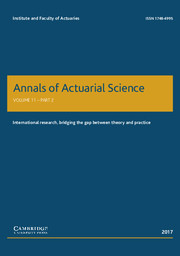Article contents
Optimal reinsurance under multiple attribute decision making
Published online by Cambridge University Press: 17 November 2015
Abstract
We apply methods from multiple attribute decision making (MADM) to the problem of selecting an optimal reinsurance level. In particular, we apply the Technique for Order of Preference by Similarity to Ideal Solution method with Mahalanobis distance. We consider the classical risk model under a reinsurance arrangement – either excess of loss or proportional – and we consider scenarios that have the same finite time ruin probability. For each of these scenarios we calculate three quantities: released capital, expected profit and expected utility of resulting wealth. Using these inputs, we apply MADM to find optimal retention levels. We compare and contrast our findings with those when decisions are based on a single attribute.
Keywords
Information
- Type
- Papers
- Information
- Copyright
- © Institute and Faculty of Actuaries 2015
References
- 6
- Cited by

